
- Home
- Garden Wildlife
- Insects
- Beetles
- Pond beetles
The vegetarian water beetles in the Hydrophilidae family number about 40 aquatic species. Others in the family are dung and detritus beetles on land. They are mostly 2-8mm long but some are larger. While some species can swim through the water, most crawl around on vegetation or in algal mats close to the margins of ponds. The adult beetles feed on foliage and plant debris but the larvae are predators of small pond creatures. These beetles come to the surface head first when they need to breathe and they gather an air bubble with the aid of their clubbed antennae.
We have 20 species of Helophorid beetles, between 2 and 7mm long, often called water scavenger beetles. The common Helophorus brevipalpis has a metallic green colour and strongly ridged thorax. They do not swim but crawl through vegetation, feeding on plants and decomposing material.
The Scirtidae or marsh beetles are very small and poorly known, associated with damp vegetation. The aquatic larvae favour rather stagnant conditions. Some adults can jump using their hindmost legs, rather like fleas.
Life cycle
Pond beetles usually lay their eggs on submerged plants. Vegetarian water beetles deposit their eggs in silk packets that are attached to plants. The larvae pass through several instars before they are fully fed. When ready to pupate, they burrow into mud near the pond margin. Most pond beetles overwinter as pupae and emerge as adults between late spring to late summer. During warm weather, pond beetles will emerge from the water and fly away to colonise new ponds and somesuch as the Scirtidae are caught in moth traps.
Role of pond beetles in gardens
The predatory habits of many large pond beetles may make them unpopular with pond owners who treasure their fish and tadpoles. However, they are part of the predatory fauna that occurs in a healthy pond habitat and so should be tolerated. Predatory pond beetles and their larvae also help reduce the numbers of mosquitoes and other blood-sucking flies that breed in ponds.
Other sources of information
Websites
Web site of the Aquatic Coleoptera Conservation Trust, covering endangered Biodiversity Action Plan aquatic beetles
Web site of The Coleopterists Society
Mark Telfer’s beetle site
UK Beetle Recording Beetle Families
Books
Dobson,M. Pawley,S. Fletcher,M. & Powell, A. (2012) Guide to Freshwater Invertebrates Published by Freshwater Biological Association
Foster, G. N., Bilton, D. T. & Friday, L. E. (2014) Handbooks for the Identification of British Insects. Vol 4 part 5b Keys to adults of the water beetles of Britain and Ireland (part 2). Royal Entomological Society
Foster, G. N. & Friday, L. E. (2011) Handbooks for the Identification of British Insects. Vol 4 part 5 Keys to adults of the water beetles of Britain and Ireland (part 1). Royal Entomological Society
Friday, L. E. (1988) A key to the adults of British water beetles. A Field Studies Council AIDGAP key
By Andrew Halstead reviewed by Andrew Salisbury edited by Steve Head
![Evanherk [Public domain], via Wikimedia Commons](images/Dytiscus adult.jpg)
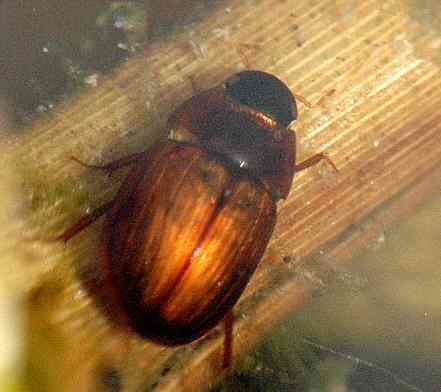
![By Udo Schmidt from Deutschland (Helophorus brevipalpis Bedel, 1881) [CC BY-SA 2.0 (https://creativecommons.org/licenses/by-sa/2.0)], via Wikimedia Commons](images/Helophorus_brevipalpis.jpg)
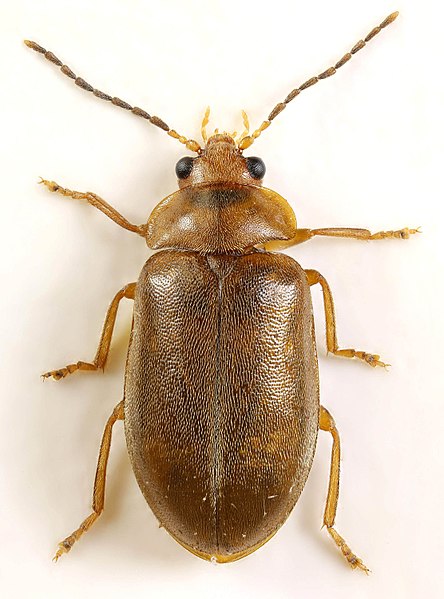
Example of water beetle families. From the left Dytiscidae Dytiscus marginalis showing the swimming third legs; the hydrophilid Enochrus testacea; the helophorid Helophorus brevipalpis and the scirtid Microcara testacea.
Whirligig beetles are the most recognisable water beetles because of their habit of swimming at speed in a circular fashion on the water surface. Most of the 12 species recorded in Britain and Ireland occur on rivers or lakes. The species commonly seen in garden ponds is Gyrinus substriatus, which is 5-7mm long.
![James Lindsey at Ecology of Commanster [CC BY-SA 2.5 (https://creativecommons.org/licenses/by-sa/2.5) or CC BY-SA 3.0 (https://creativecommons.org/licenses/by-sa/3.0)], via Wikimedia Commons](images/Gyrinus.substriatus.jpg)
![By gailhampshire from Cradley, Malvern, U.K (Dytiscidae . Gyrinus species. Whirligig Beetles.) [CC BY 2.0 (https://creativecommons.org/licenses/by/2.0)], via Wikimedia Commons](images/Whirligig_Beetles.jpg)
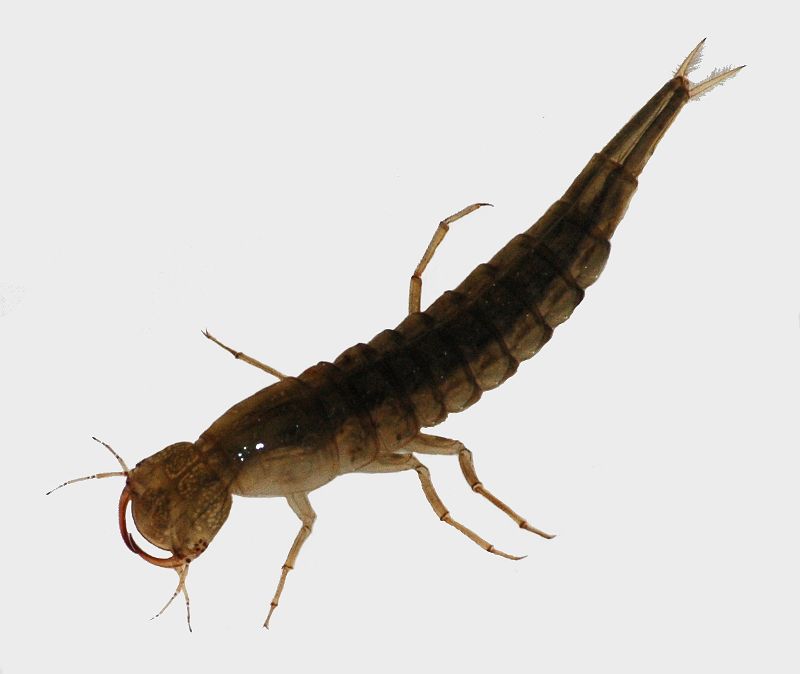
There are more than 100 dytiscid beetles in Britain, and most are in the 3-15mm size range. The garden pond species include Dytiscus marginalis, the Great Diving Beetle, which at 26-32mm long is one of the largest. Dytiscid beetles have a fringe of long hairs on the hind legs, which are used to propel the beetle through the water, where they prey on small fish, tadpoles and pond insects. The larvae are also voracious predators. Some dytiscid beetles overwinter as adults and may be seen swimming under ice. The males of some species have enlarged tarsi on their front legs; these are used to grasp females during mating. Dytiscid beetles come to the surface to breathe and they collect a bubble of air in hairs on the tip of their abdomen.
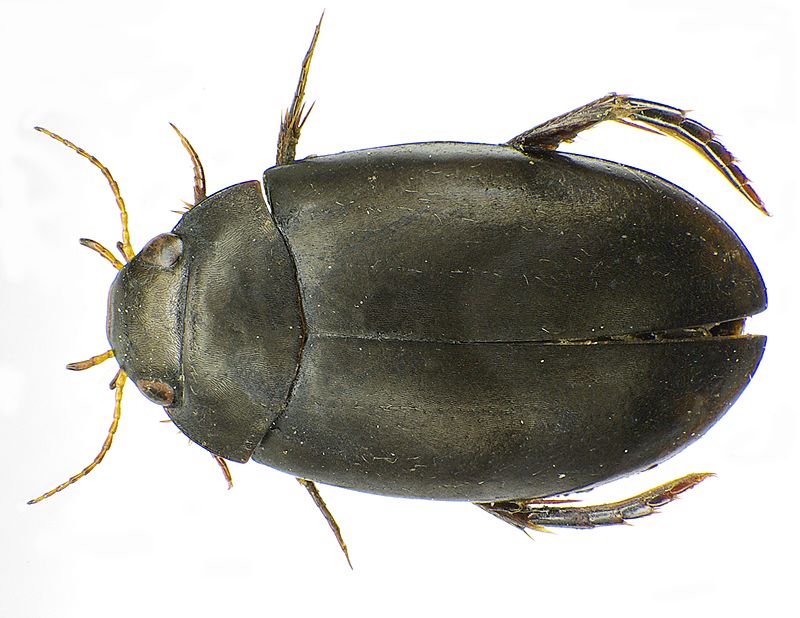
Left: larva of Dytiscus marginalis.
Right: Another common dytiscid beetle in garden ponds, Agabus pustulatus, about 10mm long.
Whirligig beetles feed at the water surface on insects that have fallen in the water. They are gregarious and often cluster together when swimming in circles. The middle and hind pairs of legs are much shorter and thicker than the front pair. They are used like oars. A unique feature of whirligig beetles is that they have two pairs of compound eyes. One pair is for seeing below the water surface, while the other pair is looking above the water. The larvae live in the water where they prey on other small pond creatures.
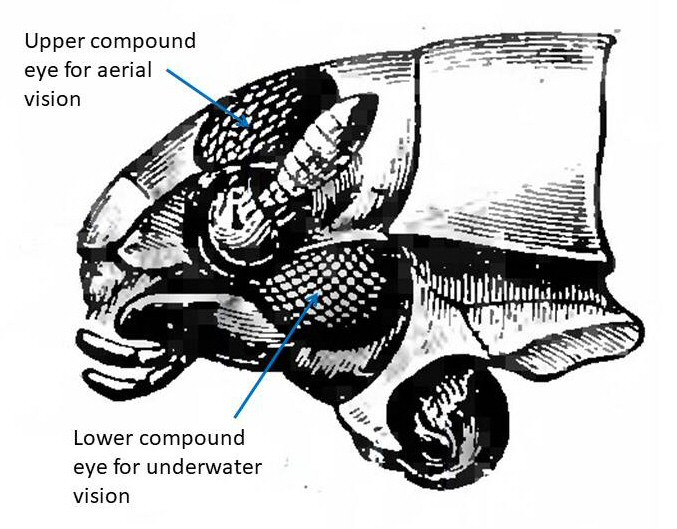
Pond Beetles
There are many aquatic beetles that live in small bodies of still water, such as garden ponds. These beetles often have a similar appearance with a body that is a smooth, flattened, oval shape that enables them to move through water more easily. One or more pairs of the legs have modifications with flanges or hairs that enable them to propel the beetle through the water.
Species in Britain and Ireland
12 families of beetles in Britain are associated with water, in freshwater, mud and even saltmarsh. Altogether there are about 470 species. Jennifer Owen had a small pond in her Leicester garden but her scientific collecting was primarily land-based. Even so she recorded 12 species of water beetles from three families.
The families likely to be seen in gardens are the Dytiscidae (diving beetles), Hydrophilidae, Helophoridae, Scirtidae (marsh beetles) and Gyrinidae (whirligig beetles)
Above: Whirligig beetles in the family Gyrinidae. Left - the common Gyrinus substriatus and right - a swarm of whirligig beetles showing the way they dimple the water surface on which they move.

Pond Beetles
There are many aquatic beetles that live in small bodies of still water, such as garden ponds. These beetles often have a similar appearance with a body that is a smooth, flattened, oval shape that enables them to move through water more easily. One or more pairs of the legs have modifications with flanges or hairs that enable them to propel the beetle through the water.
Species in Britain and Ireland
12 families of beetles in Britain are associated with water, in freshwater, mud and even saltmarsh. Altogether there are about 470 species. Jennifer Owen had a small pond in her Leicester garden but her scientific collecting was primarily land-based. Even so she recorded 12 species of water beetles from three families.
The families likely to be seen in gardens are the Dytiscidae (diving beetles), Hydrophilidae, Helophoridae, Scirtidae (marsh beetles) and Gyrinidae (whirligig beetles)
![Evanherk [Public domain], via Wikimedia Commons](images/Dytiscus adult.jpg)
![James Lindsey at Ecology of Commanster [CC BY-SA 2.5 (https://creativecommons.org/licenses/by-sa/2.5) or CC BY-SA 3.0 (https://creativecommons.org/licenses/by-sa/3.0)], via Wikimedia Commons](images/Gyrinus.substriatus.jpg)
![By gailhampshire from Cradley, Malvern, U.K (Dytiscidae . Gyrinus species. Whirligig Beetles.) [CC BY 2.0 (https://creativecommons.org/licenses/by/2.0)], via Wikimedia Commons](images/Whirligig_Beetles.jpg)
![By Udo Schmidt from Deutschland (Helophorus brevipalpis Bedel, 1881) [CC BY-SA 2.0 (https://creativecommons.org/licenses/by-sa/2.0)], via Wikimedia Commons](images/Helophorus_brevipalpis.jpg)

Example of water beetle families. Top left Dytiscidae Dytiscus marginalis showing the swimming third legs; top right hydrophilid Enochrus testacea; bottom left the helophorid Helophorus brevipalpis and bottom right the scirtid Microcara testacea.
Whirligig beetles are the most recognisable water beetles because of their habit of swimming at speed in a circular fashion on the water surface. Most of the 12 species recorded in Britain and Ireland occur on rivers or lakes. The species commonly seen in garden ponds is Gyrinus substriatus, which is 5-7mm long.

Above: Whirligig beetles in the family Gyrinidae. Left - the common Gyrinus substriatus and right - a swarm of whirligig beetles showing the way they dimple the water surface on which they move.
The vegetarian water beetles in the Hydrophilidae family number about 40 aquatic species. Others in the family are dung and detritus beetles on land. They are mostly 2-8mm long but some are larger. While some species can swim through the water, most crawl around on vegetation or in algal mats close to the margins of ponds. The adult beetles feed on foliage and plant debris but the larvae are predators of small pond creatures. These beetles come to the surface head first when they need to breathe and they gather an air bubble with the aid of their clubbed antennae.
We have 20 species of Helophorid beetles, between 2 and 7mm long, often called water scavenger beetles. The common Helophorus brevipalpis has a metallic green colour and strongly ridged thorax. They do not swim but crawl through vegetation, feeding on plants and decomposing material.
The Scirtidae or marsh beetles are very small and poorly known, associated with damp vegetation. The aquatic larvae favour rather stagnant conditions. Some adults can jump using their hindmost legs, rather like fleas.
Life cycle
Pond beetles usually lay their eggs on submerged plants. Vegetarian water beetles deposit their eggs in silk packets that are attached to plants. The larvae pass through several instars before they are fully fed. When ready to pupate, they burrow into mud near the pond margin. Most pond beetles overwinter as pupae and emerge as adults between late spring to late summer. During warm weather, pond beetles will emerge from the water and fly away to colonise new ponds and somesuch as the Scirtidae are caught in moth traps.
Role of pond beetles in gardens
The predatory habits of many large pond beetles may make them unpopular with pond owners who treasure their fish and tadpoles. However, they are part of the predatory fauna that occurs in a healthy pond habitat and so should be tolerated. Predatory pond beetles and their larvae also help reduce the numbers of mosquitoes and other blood-sucking flies that breed in ponds.
Other sources of information
Websites
Web site of the Aquatic Coleoptera Conservation Trust, covering endangered Biodiversity Action Plan aquatic beetles
Web site of The Coleopterists Society
Mark Telfer’s beetle site
UK Beetle Recording Beetle Families
Books
Dobson,M. Pawley,S. Fletcher,M. & Powell, A. (2012) Guide to Freshwater Invertebrates Published by Freshwater Biological Association
Foster, G. N., Bilton, D. T. & Friday, L. E. (2014) Handbooks for the Identification of British Insects. Vol 4 part 5b Keys to adults of the water beetles of Britain and Ireland (part 2). Royal Entomological Society
Foster, G. N. & Friday, L. E. (2011) Handbooks for the Identification of British Insects. Vol 4 part 5 Keys to adults of the water beetles of Britain and Ireland (part 1). Royal Entomological Society
Friday, L. E. (1988) A key to the adults of British water beetles. A Field Studies Council AIDGAP key
By Andrew Halstead reviewed by Andrew Salisbury edited by Steve Head
Whirligig beetles feed at the water surface on insects that have fallen in the water. They are gregarious and often cluster together when swimming in circles. The middle and hind pairs of legs are much shorter and thicker than the front pair. They are used like oars. A unique feature of whirligig beetles is that they have two pairs of compound eyes. One pair is for seeing below the water surface, while the other pair is looking above the water. The larvae live in the water where they prey on other small pond creatures.

There are more than 100 dytiscid beetles in Britain, and most are in the 3-15mm size range. The garden pond species include Dytiscus marginalis, the Great Diving Beetle, which at 26-32mm long is one of the largest. Dytiscid beetles have a fringe of long hairs on the hind legs, which are used to propel the beetle through the water, where they prey on small fish, tadpoles and pond insects. The larvae are also voracious predators. Some dytiscid beetles overwinter as adults and may be seen swimming under ice. The males of some species have enlarged tarsi on their front legs; these are used to grasp females during mating. Dytiscid beetles come to the surface to breathe and they collect a bubble of air in hairs on the tip of their abdomen.
Left: larva of Dytiscus marginalis. Right: Another common dytiscid beetle in garden ponds, Agabus pustulatus, about 10mm long.










